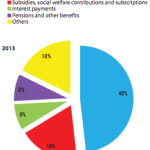The base period for measuring real Gross Domestic Product (GDP) or national productivity of the Maldives has been updated from 1995 to 2003, the Department of National Planning revealed this week.
Real GDP is an inflation-adjusted measure that reflects the value of goods and services produced within a country in a given year expressed in base-year prices.
“Changing the base period to a more recent year improves the accuracy of GDP estimates,” reads a press statement by the department. “Internationally, regularly changing the base period is encouraged. In most countries GDP is rebased once every five or ten years. Maldives’ GDP has been rebased after an eight year period.”
With the change in the base period, real GDP in 2011 is now calculated at Rf21,123 million while GDP per capita rises to Rf4,061, an increase of Rf1,217 from previous estimates.
“Among the reasons for the difference, apart from richer information used to calculate GDP, include changes to methodology,” the statement explains.
A “supply and use table” based on all transactions that occurred in 2003 was employed as a benchmark for rebasing GDP.
“In the rebased series extensive use was made of new available data, including annual accounts, government budget details, survey data, and price and unit value indices. The rebasing exercise took approximately three years to complete,” reads a report by the department.
Based on the 2003 series, it notes, real GDP on average grew 7.9 percent each year during the past decade, compared to 5.8 percent under the 1995 series.
Inflation
According to the last monthly economic review by the Maldives Monetary Authority (MMA), the pace of GDP growth in 2011 is projected at 4 percent.
Tourist arrivals registered a 15 percent increase in the first two months of 2011 compared to the same period last year while fish catch showed growth of 31 percent from 2010.
Increase in food prices meanwhile contributed to half of inflation in February 2011.
According to the planning department, the consumer price index (CPI) for Male’ last month rose by 5.6 percent compared to March 2010.
Compared to the previous year, the highest inflation was recorded for education with 23 percent – driven by a 42 percent increase in school fees – followed by fish products, which rose by 14 percent.
Food items such as coconut, green chili, watermelon, chicken sausage and oranges, showed a price increase between 25 percent to 70 percent.
However, the monthly inflation rate was low at 1.30 percent and showed deflation of 0.07 percent excluding fish.





